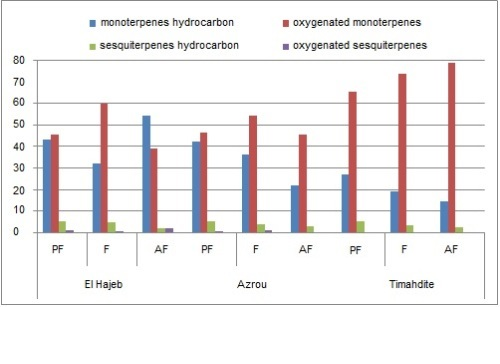
Chemical composition and antibacterial activity of Thymus zygis subsp. gracilis (Boiss.) R. Morales essential oils from Morocco
Abstract
Full Text:
PDFReferences
- R.L. Carson: Silent spring. Riverside Press. Cambridge, MA, USA, 1962.
- OMS, L'utilisation des pesticides en agriculture et ses conséquences pour la santé publique. Genève, Suisse, 1991, 96(16) l50p.
- H.M.G. Van der Werf, Agr. Ecosyst. Environ., 1996, 60(2), 81-96.
- M. Lis-Balchin and S.G. Deans, J. Appl. Microbiol., 1997, 82, 759-762.
- K.A. Hammer, C.F. Carson, T.V. Riley, J. Appl. Microbiol., 1999, 86, 985-990.
- M.G. Miguel, a short review, Molecules, 2010, 15(12), 9252-9287.
- M. Zuzarte, M.J. Gonçalves, J. Canhoto and L. Salgueiro, Chemistry and Biodiversity, 2011, 8, 924-936.
- J.R. Soares, T.C. Dinis, A.P. Cunha and L.M. Almeida, Free Radical Res., 1997, 26(5), 469-478.
- I. Rasooli and S.A. Mirmostafa, Fitoterapia, 2002, 73, 244-250.
- M.G. Miguel, M. Simöes, A.C. Figueiredo, J.C. Barroso, L.G. Pedro and L. Carvalho, Food Chem., 2004, 86, 183-188.
- M. Hazzit, A. Baaliouamer, A.R. Verissimo, M.L. Faleiro, and M.G. Miguel, Food Chem. 2009, 116, 714-721.
- S.A. Dandlen, A.S. Lima, M.D. Mendes, M.G. Miguel, M.L. Faleiro, M.J. Sousa, L.G. Pedro, J.G. Barroso and A.C. Figueiredo, Flavour and fragrance, 2010, 25(3), 150-155.
- M. Fennane, M. Ibn Tatou, Flore Pratique du Maroc, Volume 2. Trav. Inst. Sci. Rabat. Sér. Bot. 38, 2007.
- R. Morales, The history, botany and taxonomy of the genus Thymus. In: Thyme: the genus Thymus; ed. by Stahl-Biskup E & Sáez F; Taylor & Francis, London, 2002, pp. 1-43.
- E. Stahl-Biskup, a review of the literature 1960–1989, J. Essent. Oil Res., 1991, 3, 61-82.
- R. Morales, Ruizia, 1986, 3, 5-324.
- P.S. Gómez, J.A.S. Sánchez, M.C.S. Cano, E.C. Castellanos, and M.C.G. Vallejo, J. Essent. Oil Res., 1995, 7, 399-402.
- T. Adzet, R. Granger, and J. Passet, Biochemical Systematics and Ecology, 1977, 5, 269-272.
- F. Sáez, Phytochemistry, 1995b, 40, 819-825.
- R.P. Sánchez, J.L Ubera, F. Lafont and C. Gálvez, Journal of Essential Oil Research, 2008, 20(3), 192-200.
- R. Morales, Anales Jard. Bot. Madrid., 1994, 51(2), 205-236.
- H. Richard, B. Benjilali, N. Banqourou and O. Baritaux, Lebensm-Wiss. U. Technol., 1985, 18, 105-110.
- N. Lattaoui, A. T. Elaraki and A.J. Errifi, J. Essential Oil Res., 1993, 5, 45-53.
- A. Jaafari, H. Ait Mouse, El M. Rakib, L. Ait M’barek, M. Tilaoui, C. Benbakhta, A. Boulli, A. Abbad and A. Zyad, Rev. Bras. Farmacogn., 2007, 17(4), 477-491.
- F. Amarti, M. El Ajjouri, M. Ghanmi, B. Satrani, A. Aafi, A. Farah, A. Khia, A. Guedira, M. Rahouti, A. Chaouch, Phytothérapie, 2011, 9(3), 149-157.
- G. Bell and M.J. Lechowicz, J. Eco., 1991, 79, 663-685.
- M. Tarayre, J.D. Thompson, J. Escarré and Y.B. Linhart, Oecologia, 1995, 101, 110-118.
- P.H. Gouyon, P. Vernet, J.L. Guillerm, G. Valdeyron, Heredity, 1986, 57, 59-66
- N. Lattaoui and A.T. Elaraki, Riv. Ital. EPPOS., 1994, 13, 13-19.
- H. Ismaili, L. Milella, S.F. Tetouani, A. Ilidrissi, A. Camporese, S. Sosa, G. Altinier and R.D.L. Aquino, J. Ethnopharmacol., 2004, 91, 31-36.
- K. El Habazi, A. Ouacherif, A. Laroubi, R. Aboufatima, A. Abbad, A. Benharref, A. Zyad, A. Chait and A. Dalal, Afr. J. Microbiol., 2008, 2, 262-267.
- L. El Bouzidi, C.A. Jamali, K. Bekkouche, L. Hassani, H. Wohlmuth, D. Leach and A. Abbad, Industrial Crops and Products, 2013, 43, 450-456.
- I. Wendelin, R. Gasser and E.C. Reisihgera, Journal of Spirochetal and Tick Borne Diseases, 1997, 4, 7-10.
- M.M. Martins, M.G.B. Gil, M.L.B da Costa and M. Rouzet, Flavour Fragr. J., 1999, 14, 177-182.
- J.B. Salas, Contribución al conocimiento de los recursos fitogenéticos de Extremadura: el caso de los tomillos. Doctoral thesis. Univ. Extremadura [In Spanish] 2005.
DOI: http://dx.doi.org/10.13171/mjc.3.1.2014.01.04.18
Refbacks
- There are currently no refbacks.
Copyright (c) 2015 Mediterranean Journal of Chemistry
